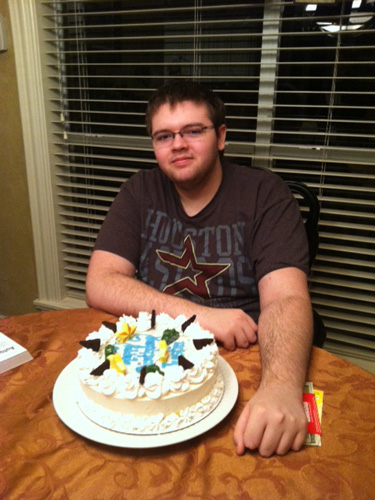
“Dysfunction of the autonomic nervous system can cause a number of health problems related to the functions it controls, including heart rate, blood pressure, digestive tract peristalsis and sweating, among other things,” says pediatric neurologist Ian Butler, MD, Adriana Blood Professor in Neurology and director of the division of Child and Adolescent Neurology at McGovern Medical School at UTHealth, who with pediatric cardiologist Mohammed Numan, MD, operates a combined child neurology and cardiology clinic for dysautonomia patients at Children’s Memorial Hermann Hospital. “Because of the complexity of the disorder and array of symptoms it produces, these kids are easy to miss and difficult to diagnose. Like Justin, they end up going from specialist to specialist. Years may pass before their parents have a conclusive diagnosis.”
Born in 1995 at 36 weeks, Justin had health challenges from birth. “He had severe GI symptoms, so we saw a gastroenterologist,” says his mother Meredith Lamb. “He had migraines that were treated by his pediatrician. Later he developed some problems with walking, but his health issues never dramatically improved or worsened until he contracted the H1N1 flu virus in 2009. The flu started a downward spiral that we later learned is characteristic of dysautonomia.” From influenza, Justin went to pneumonia and pleurisy. When he developed more serious problems with walking and began posturing his hands strangely, Lamb took him to an orthopedist, who recognized his symptoms as neurological and referred them to Dr. Butler.
On one visit to Dr. Butler, Lamb mentioned that her son had experienced dizziness, which, along with Justin’s overall presentation, prompted the neurologist to consider dysautonomia. He referred him to Dr. Numan for a tilt table test, the gold standard for diagnosis of the disorder. Patients are strapped to the tilt table lying flat, then tilted upright to about 70 degrees. The 30-minute test is considered positive if the patient experiences symptoms associated with a drop in blood pressure, such as fainting or cardiac arrhythmia.
Their physicians order one diagnostic test after another. When there are no findings – a common occurrence with dysautonomia – the disorder is mislabeled as psychogenic. But the kids are suffering, and they get depressed when they’re unable to find help.
“The tilt table test reproduces the clinical manifestations of dysautonomia, giving us a clear indication that the autonomic nervous system is malfunctioning,” says Dr. Numan, an associate professor in the division of Pediatric Cardiology at McGovern Medical School. “This is particularly important because it’s very common for dysautonomia patients to be misdiagnosed with psychological disorders. They suffer from overwhelming fatigue. They have nausea that’s not always explainable. They complain bitterly of pain in their shoulders, back and legs. Some complain of tingling in their hands and feet. The body is trying to compensate for lack of oxygenated blood, and it shuts down blood flow to muscles and non-vital organs. Their physicians order one diagnostic test after another. When there are no findings – a common occurrence with dysautonomia – the disorder is mislabeled as psychogenic. But the kids are suffering, and they get depressed when they’re unable to find help.”
After the tilt table test, Justin was diagnosed with dysautonomia. Dr. Numan also found an atrial septal defect of the heart and closed the hole in an endovascular repair in December 2011.
When we started looking for a medical home for our dysautonomia patients, it seemed natural to approach TIRR Memorial Hermann.
For Justin and other children and adolescents with dysautonomia, acute care is only the first step in treatment. “These children become deconditioned very quickly,” Dr. Butler says. “We use medications to increase the vascular volume to the brain because the blood tends to pool in the legs and pelvis. Many are in physical therapy. When we started looking for a medical home for our dysautonomia patients, it seemed natural to approach TIRR Memorial Hermann. We contacted hospital leadership, and they put together a round table. We discovered we were speaking the same language. We do tilt table testing; they use a tilt table therapeutically. Our patients do well in aquatic therapy; they have a strong aquatic program. It was a good fit.”
Teresa Cramer, PT, DPT, PCS, pediatric clinical coordinator at TIRR Memorial Hermann Outpatient Rehabilitation at the Kirby Glen Center, spent time observing the two physicians and their patients in clinic and learned about symptoms and health issues. “This is familiar territory for us,” Cramer says. “Frequently patients with traumatic brain injury or spinal cord injury have autonomic nervous system dysfunction. Dysautonomia symptoms can range from very mild to very debilitating, and these patients need specialized care. We put together a core team to work with Drs. Butler and Numan, and trained our staff using what we learned from them and from the pertinent rehabilitation literature. The result is a multimodal approach to therapy that provides dysautonomia patients with the help they need consistently.”
Jessica Dalmolin, DPT, was Justin’s physical therapist at TIRR Memorial Hermann Outpatient Rehabilitation at the Kirby Glen Center. “With dysautonomia patients we emphasize cardiovascular exercise to increase blood flow to the muscles in positions that decrease orthostatic stress, including supine, prone, recumbent and sitting positions,” she says. “As they build up tolerance we add more upright exercise, incorporating yoga, Pilates and light weights, as well as balance and stretching exercises. We slowly progress to a standing position. They exercise with a heart rate monitor so we can track their exertion during the session, and we ask them to monitor their symptoms at home by keeping a journal. They record any exercise they do at home, how long they slept, if they had any lightheadedness, headaches or brain fog after their therapy session. If they’re exhausted the day after their session, we know we have to adjust their therapy program. The journal helps us personalize treatment to their particular needs.”
Justin’s journal gave Dalmolin a good picture of what he experienced during the week he kept it. “He’s a great kid with a really supportive mom,” she says. “She let him lead and take charge of his own treatment, but if he had questions, she was there to help. Like many kids with dysautonomia, Justin was very in tune with his body and well educated about the disorder. He was willing to work hard and was not afraid to let me know when symptoms or fatigue got the best of him. His mom is a great advocate for him and for the dysautonomia population.”
Meredith Lamb and her family, including 24-year-old son Marc who has a milder form of dysautonomia, are committed to raising awareness about the disorder. In May 2013, they formed the Lamb Foundation for Dysautonomia Research to raise funds in support of studies being conducted at Children’s Memorial Hermann Hospital and McGovern Medical School. Drs. Butler and Numan have several research projects under way or completed, including the role of histamine and mast cells in dysautonomia, cerebrospinal fluid neurotransmitters, immunomodulation treatment protocols and DNA studies utilizing whole exome analysis of families.
It’s not uncommon for more severe cases of dysautonomia to rob teenagers of their high school years. “Justin still has good days and bad days,” his mother days. “The bad days made him miss his entire high school experience. He tried to go back to school twice but became sick and came home again. We did an online high school program and he did pretty well in his sophomore year, but then he was too sick to keep up. We tried home schooling. He will get his GED, and we will move on.
“Dr. Butler, Dr. Numan and TIRR Memorial Hermann are family now,” Lamb adds. “We spent years going from specialist to specialist. We’re very grateful for the help we’ve found.”
Justin resumed physical therapy and began aquatic therapy at TIRR Memorial Hermann-The Woodlands’ new outpatient center in December 2013.

Nationally Ranked Rehabilitation
For the 35th consecutive year, TIRR Memorial Hermann is recognized as the best rehabilitation hospital in Texas and No. 2 in the nation according to U.S. News and World Report's "Best Rehabilitation Hospitals" in America.
Learn More